The Basics of Pond Care by Clifford Woods 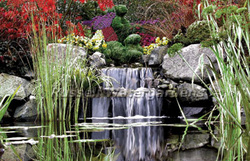 Proper pond care is comparatively straightforward on the condition that the pond is well-made in advance of putting fish into it as well as being properly maintained when in operation.
With both ponds and pools, you need to make sure that the proper water levels are taken care of, either by filling it in excess for the duration of hot weather seasons or depleting it in the course of rainier periods. This will prevent undue weathering of exposed areas of pond liner or erosion of banks if flooding occurs.
Splits in cement or holes in liners can often be fixed, however it is quite time intensive and certainly an issue worthy of avoidance. Appropriately blended cement should never fracture even during extreme climate changes. Most shredding in liners is a result of inappropriate selection of the proper fish pond liner in advance of installation, additional reasons are the feared visits from the otter, heron, raccoon, and other similar animals whose razor-sharp claws can effortlessly pierce weaker pond liners.
Fish Care
Assuming that your pond water is properly oxygenated and fish aren't over-fed, the fish should continue to be healthy. However, if you do observe fish behaving out of character or floating around too lethargically then in that case it is advisable to contact your local pond fish authorities. Protrusions or skin lesions are evident indications of stressed fish and really should be dealt with the instant it is observed.
Once again, a quick call to your own personal local fish pond treatment company to ask for a precise analysis and what therapy should be done is usually adequate to save your pond fish.
Seasonal Care
The later part of the fall and winter are generally not the ideal times of year to thoroughly clean your pond, as you will most likely disrupt all of the vegetation and fish attempting to adapt to the winter season. A few plants send down sprouts to the bottom level of the pond exactly where they sit until the weather conditions become a bit warmer.
The perfect time for an effective clean up is in early spring, following the last frosts, whenever pond life is back to being lively and the fish start to eat actively. Normally it is not recommended to completely drain and clean out ponds as this tends to get rid of the friendly microorganisms as well.
Improve Appearance and Protect Your Pond
To enhance the visual appeal of the pond as well as to protect against disease, get rid of any decaying plant life from the water and small vegetation following the initial couple of frosts at the beginning of fall, excessive floating vegetation that appears lifeless also needs to be taken out with a net or rake.
Fish during this period aren't going to be feeding and will essentially survive on their very own body fats for the rest of the winter season. Be sure you provide them with sufficient protection by means of ledges, rocks, or extremely deep water where they are able to hide securely.
Algae
Green unclean water is a frequent issue with more compact ponds. A small amount of algae exists in all water; having said that, in lengthier intervals of sunlight even an ideal equilibrium of fish and plants is just not sufficient for complete avoidance and the water can becomes a livid green color. In tiny still-water garden ponds this can be prevented with the setup of a purification unit such as UV sterilizers.
The UV light can eliminates algae cells, while the filtration system gets rid of its inactive organic matter well before it can lead to more complications. One particular method for eliminating algae would be to use an algaecide abundant with beneficial microorganisms.
A probiotics solution may be helpful in getting rid of algae completely as well as boost the overall health of the pond environment.

 Caring For Your Koi Pond During Spring
By Clifford Woods
Throughout the spring, your Koi fish pond will become more active. For most of their time during their deep winter sleep, the existing creatures in your pond are preparing to spring alive at the very first indications of the warm weather. This point is the most ideal time to care for your fish pond and preserve it well before your fish, vegetation, and other organisms in your pond return to life from their deep hibernation. Considerable changes will be taking place as the days and nights become warmer.
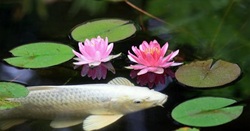 Simply keep track of temperatures and when it reaches about fifty degrees on average this will be about the most ideal time to take care of your Koi pond.
The upkeep necessary for your fish pond is dependent upon just what has occurred throughout the winter months. A harsh winter calls for even more modifications than normal. This is one of the reasons that it is a smart idea to start once caring for your pond as soon as you notice alterations in the climate. Always remember that servicing in the springtime must be carried out on an annual basis, regardless of how minor or severe the prior winter season has been.
Pay attention to the water quality of your Koi pond. You will observe that the pond's water is extremely clear when the conditions change from winter to spring. Do not let this clear appearance deceive you, because there are going to be variables which will result in serious complications once summer comes along if you do not solve these problems at the earliest opportunity.
 Throughout the autumn and winter months, leaves along with other plant substances could possibly have found its way into the fish pond. Despite the fact that the water appears clear, these components have inserted considerable amounts of nourishment in the water, which will lead to immediate algae development once the spring hits.
In addition, large quantities of natural materials in the pond will begin to go through decomposition, which will reduce the oxygen levels in the water. Now, because the water in your pond is extremely clear, this will be the ideal chance to clear all those undesirable debris and wastes.
You can accomplish this by:
- Employing a fine mesh net to scoop out most of those particles. At this point, the only real issue here is that many nets are only going to cause more debris in your pond as opposed to eliminating them from it.
- Once you have taken out those unnecessary particles and wastes, test out the quality of your water. The winter months would have caused changes in the pH quantities of the fish pond. At the start of the spring season, the pH volume of the water should be eight.
- Above all else, always remember to take care of and look after your fish. Take into account that spring is an extremely vulnerable time for your fish since they have not ingested any food for ages and they've been dwelling on a fairly low amount of energy. This could cause your fish to be far more susceptible to problems with harmful bacteria, viruses, fungi, and parasites. At this point in time, it is an excellent idea to take every one of the essential precautionary actions for your Koi and the overall health of the pond.
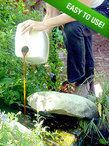 Manage your Koi pond with the addition of a probiotic algaecide solution filled with beneficial microorganisms which will substantially reduce those dangerous infestations and debris. As soon as the weather warms up, an additional amount of this kind of treatment solution will secure the well-being of your Koi as they rebuild their own defense systems.

All about Pond Magician and How to Use it Effectively
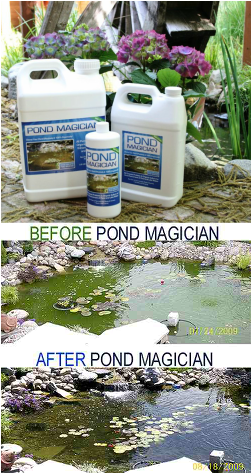 Pond Magician is made up of an incredible number of beneficial microorganisms that maneuver through your pond and consume the microbes and contaminants which make your pond unpleasant as well as foul-smelling.
Unlike similar pond cleaners which exclusively deal with natural materials, Pond Magician is made up of both aerobic and anaerobic beneficial microorganisms, therefore making it easily adaptable to a large selection of pond water situations.
What are Beneficial Microorganisms?
Beneficial microorganisms are composed of billions of friendly microorganisms. Generally, they simply eat up the algae and unwanted organisms. These microbes are advantageous to the water, plants, and fish life that thrive within your pond and they can be extremely eager for the impurities and organisms which make your pond unclean.
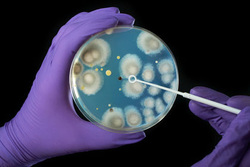 A few of the beneficial microorganisms can flourish even within environments where there is little if any breathable oxygen available. For this reason, beneficial microorganisms are quite effective regardless of the situation. Apart from being less expensive when compared with other deodorizing remedies, the application process is quite easy.
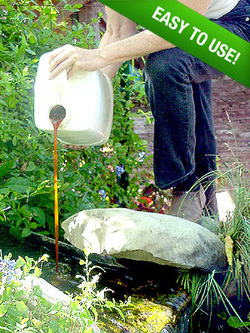 How to Use Pond Magician and Determine the Quantity Needed
Pond Magician is incredibly user-friendly. Simply pour it into your pond directly from the container. Put just a little at a handful of locations around the border of the pond or even dump it into the flow or waterfall for those who have one. The concept is to get the solution equally distributed within the pond.
You may also apply it on top of the pond's surface area with a backyard sprayer. This can help in the case that you have a large amount of surface algae.
Before you apply it, first you have to determine the amount of gallons in your pond by employing this basic formula:
- Multiply the average length in feet of the pond by the average width in feet.
- Then multiply that answer by the average depth in feet.
- Then multiply that answer by 7.48.
- This answer is the approximate number of gallons in your pond.
After that, making use of the guidelines below will determine the quantity of Pond Magician you will need for two applications.
- 0-1,000 Gallons = 1 Quart
- 1000-5000 Gallons = 1 Gallon
- 5,000 - 12,500 Gallons = 2.5 Gallons
- 12,500 Gallons or More = Please give us a call for precise instructions at (818) 897-4444
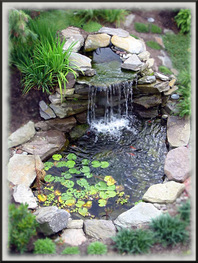 The Benefits of Pond Magician
As these beneficial microorganisms carry out their job, your pond will receive the subsequent advantages:
- The pond is going to have an extremely enjoyable, refreshing aroma.
- The pond water is going to be as healthy and crystal clear as water coming down a flowing mountain stream.
- The plants and fish will be extremely pleased and live longer.
Over dosage Precautions
Essentially, there is absolutely no chance of overdose due to the fact Pond Magician is made up of beneficial microorganisms. On the other hand, using more than needed will become significantly less cost-effective to the customer. In contrast to chemical products, where there exists a devastating consequence when overdosing occurs, organic bio-solutions only will stop functioning whenever there isn't enough excessive nourishment within the pond.
The main issue linked to overdosing beneficial microorganisms, besides cost, is the fact that when there is a great deal of natural and organic accumulation when you overdose, it is possible to induce an excessive amount of activity and need for oxygen. Basically, an over dosage of microorganisms would use up the oxygen in the water that sustains the fish. 
Algae: The Leading Cause of Fish Deaths in Ponds
by Clifford Woods 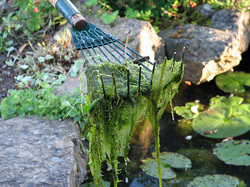
Fish pond algae are really a general name which represents all of the various types of algae, normally present in ponds. A few varieties of algae can actually be beneficial to the overall health of the pond while others types can be viewed as a real annoyance.
You will need to prevent as many algae blooms as you can in order to keep your fish and visual appealing pond vegetation alive. The most prevalent type is the floating green algae, like chlorella, euglena, and chlamydomonas varieties. They grow and reproduce quickly through cell division or spores.
Filamentous algae, also known as string algae, appear to be lengthy green noodles and have a hair-like visual aspect to them. The looks are a result of a combination of cells joined up end to end. Horse hair algae and blanket weed types like spirogyra, oedogonium, and cladophora are quite prevalent.
The Factors That Lead to Pond Algae Growth
The main three variables that enables pond algae to produce consists of: hot temperatures, vitamin abundant pond water, and crystal clear pond water that permits sunshine to pass through. A rise in temperatures speeds up both blanket weed and suspended green algae advancement.
How Various Algae Varieties Affect the Overall Health of the Fish Pond
Floating planktonic algae distribute at a speedy pace and can only be managed by ultraviolet illumination from a UV sterilizer. The UV spectrum splits the cell surfaces, resulting in the algae to collect together which in turn allows filters to easily remove the algae from the pond. An substantial amount of floating green algae can produce what is known as algae blooms. They could be devastating to pond fish as the blooms will at some point deprive the pond of oxygen thus killing off all underwater plants and fish life. 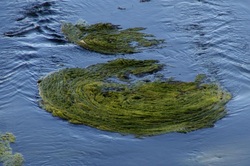 Why Too Much Algae is Harmful for Garden Ponds
Algae does not just make the pond seem unpleasant and overgrown, but in more severe situations, can actually cause the pond to smell foul. The rotting process of algae eats up oxygen from the pond water. This is especially harmful to the oxidizing bacteria and pond fish population, which both need oxygen to thrive.
Keep in mind that ammonia must be changed into nitrites by the oxidizing microorganisms. The oxidation procedure calls for vast volumes of oxygen to be able to take place. The rise in ammonia, which is additionally created by decaying algae matter, puts even more stress on the pond filtration system that houses the nitrifying microorganisms.
 How to Control Algae in Your Fish Pond
By far the most effective way of handling suspended planktonic algae is to make use of a UV clarifier or UV sterilizer. The ultraviolet spectrum eliminates the single-celled algae, resulting in it expiring and sticking to other deceased algal cells.
However, UV does not discriminate between good and bad microorganisms and will simply kill all of them. This is not really good for your fish. And not all algae are bad for a fish pond ; in fact, algae can be quite helpful to the pond because it supplies a way to obtain food for fish, presents shade from the sizzling sun, and offers as a shelter from king fishers, heron, along with various other birds.
Make an effort to cover a minimum of one third the surface area of the fish pond with plants, since they contend with algae cells for the accessible vitamins in the pond water.
Conduct regular cleaning by getting rid of string algae and blanket weed by using a garden rake.
It really is alright to have a bit of algae on pond surfaces, filtration systems, as well as other pond maintenance gear. The key is to keep it in check with a probiotics solution such as an organic algaecide created with beneficial microorganisms.
 Clifford Woods is the CEO of Effective Environmental Services
and Organic Environmental Technology.
We brew Beneficial Microorganisms that eat toxins and offer Naturally Organic Solutions.
Benefits of Having Organically Clean Ponds
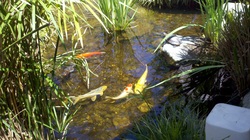 By Clifford Woods
Anyone who has a pond wishes there was some easy way to clean it out. It smells bad, so you have to clean it out occasionally to keep it healthy for any fish, so they do not get sick and die.
Even if the pond has a filter, other gadgets and products from the store, there are still going to be times when you need to clean out the pond. Ponds tend to become the most polluted parts of the environment quite often. Due to polluted water in lakes and rivers, freshwater ponds attract insects and other little creatures, which make the pond even dirtier and also turn it into a breeding ground for mosquitoes.
So, cleaning a pond is not only needed for providing a healthy environment for garden animals, such as frogs or toads, insects and your fish, but also to keep the population of mosquitoes under control. Ponds that are built well and are in harmony with nature will need less maintenance.
Something that ponds do benefit from is organic pond cleaning. This is a method that is beneficial to the health of the fish, as no harsh chemicals are used and the waste that is taken out has many other uses. The use of chemicals also drops the quality of the water making it hazardous for humans as well. In order to have organic healthy ponds; it is essential that only organic pond cleaners are used, as it can keep the ponds clean without any risk to all the life that lives there.
The pond does need to be cleaned at least once a year with the fall or spring being the best time, as the water is cooler during those months and the fish adapt better. If the pond smells bad, you have waited too long. If cleaning the pond is done on a regular basis, it will not get to the point where it might get smelly.
Move the fish to a water tank while cleaning or if you have several ponds, you can just move the fish to another pond. This makes it easier on the fish. You need a brush that is nylon for cleaning the sides of the pond. With the nylon brush, there will probably not be any need for harsh cleaners.
The silt that is on the bottom of the pond can be scraped up and be used in the garden as mulch. This silt is great for gardens and plants, and will make your garden soil really healthy. Another benefit is that this keeps all the essential minerals in the pond for the health and protection of the fish.
Cleaning your pond and using only organic pond cleaners, makes organic healthy ponds for your fish and also contributes towards a safer environment for any adults or children spending time in the yard. With pets, quite frequently drinking the pond water, the pond water will be safe for them too.
There are many ways to contribute towards a safer and healthier environment for all of us to live our lives and cleaning your fish pond organically on regular basis can be one of them.
|


















 RSS Feed
RSS Feed